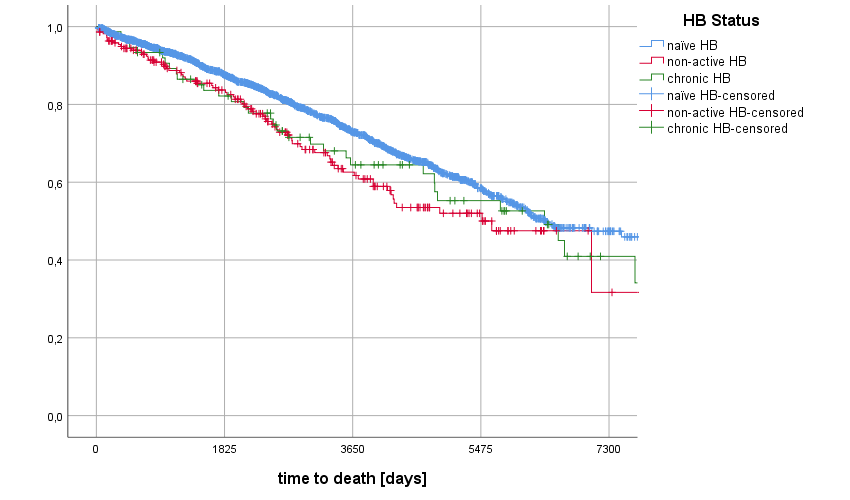Impact of Non-Active Hepatitis B after Renal Transplantation
M. G. Naik, W. Duettmann, M. Mayrdorfer, F. Halleck, K. Budde, M. Duerr
Medical Department, Division of Nephrology and Internal Intensive Care Medicine, Charité, Berlin, Germany
Meeting: 2020 American Transplant Congress
Abstract number: 284
Keywords: Graft survival, Hepatitis B, Kidney transplantation, Survival
Session Information
Session Name: All Organs: Viral Hepatitis
Session Type: Oral Abstract Session
Date: Saturday, May 30, 2020
Session Time: 3:15pm-4:45pm
 Presentation Time: 4:27pm-4:39pm
Presentation Time: 4:27pm-4:39pm
Location: Virtual
*Purpose: Hepatitis B (HB) is more frequent in dialysis patients (pts) than in the general population. Patient and graft survival in pts with chronic HB is worse. More data is needed to assess outcome of HB core antigen positive pts in current era.
*Methods: In our retrospective analysis all pts transplanted >18 years from 01.01.1990 to 31.08.2019 were grouped for their serostatus prior to transplantation. The status were defined as “naïve” for pts with negative HBsAg and HBc-antibody; as “non-active HB” for pts with positive HBc-antibody and negative HBsAg and as “chronic HB” for HBsAg positive pts.
*Results: In 2491 KTx pts, serologic markers were retrievable. We identified n=2198 HB naïve, n=218 non-active HB and n=75 chronic HB pts. Overall 484 grafts failed (19.4%) and 672 pts (27%) died. Kaplan-Meier-analysis showed a 5-year graft survival of 87.7% in the naïve, 86.0% in non-active HB and 85.4% in chronic HB group (fig1). The 10-year-graft survival was 77.9% in the naïve, 66.9% in non-active HB and 76.7% in chronic HB group. The 20-year-graft survival was 61.3% in the naïve, 53.9% in non-active HB and 31.3% in chronic HB group (p=<0.001). The 5-year-pts survival (fig2) was 87.5% in the naïve, 83.7% in non-active HB and 82.2% in chronic HB group. The 10-year-pts survival was 73.0% in the naïve, 62.6% in non-active HB and 64.5% in chronic HB group. The 20-year-ptx survival was 47.4% in naïve, 31.7% in non-active HB and 40.9% in chronic HB group (p=0.013). Overall 5-year patient and graft loss survival was 79.1% in the naïve, 74.7% in non-active HB and 69.9% in chronic HB group. The 10-year-rate was 61.1% in the naïve, 48% in non-active HB and 52.2% in chronic HB group (p<0.001). The 20-year-overall survival was 34.7% in the naïve, 31.5% in non-active HB and 14.6% in chronic HB group (p<0.001).
*Conclusions: HB leads to earlier graft loss and inferior pts survival. Of note, beside already known negative effect of chronic HB infection, also in non-active HB pts overall survival was significant worse to HB naïve pts. Thus, non-active HB status is an important risk factor for overall transplant outcome. Further studies of occult HB virus replication could add substantial value to understand the negative impact of non-active HB.
To cite this abstract in AMA style:
Naik MG, Duettmann W, Mayrdorfer M, Halleck F, Budde K, Duerr M. Impact of Non-Active Hepatitis B after Renal Transplantation [abstract]. Am J Transplant. 2020; 20 (suppl 3). https://atcmeetingabstracts.com/abstract/impact-of-non-active-hepatitis-b-after-renal-transplantation/. Accessed January 2, 2026.« Back to 2020 American Transplant Congress


